Low-Noise Design of Medium-Range Aircraft for Energy Efficient Aviation
Abstract
1. Introduction
2. Environmental Considerations
2.1. Aircraft Noise
2.2. Atmospheric Emissions
2.3. Contrails
3. SE2A Mid-Range Aircraft Applications
3. Noise and Emission Mitigation Strategies
4. DLR Simulation Process
4.1. Aircraft and Engine Design Tools
4.2. Engine Model
4.3. Noise Shielding
4.4. Flight Simulation
4.5. Overall Aircraft Noise Simulation
4.6. Verification of Simulated Noise Levels
4.7. Advanced Aircraft Concepts
5. Results
5.1. Aircraft Design
5.2. Emissions and Fuel Burn along Design Mission
5.3. Aircraft Noise Assessment along Approach and Departure
5.3.1. Current Engine Option (BPR = 6)
5.3.2. New Engine Option (BPR = 12 GTF)
6. Discussion
7. Summary
Author Contributions
Funding
Acknowledgments
Conflicts of Interest
Abbreviations
| ALT | Attachment-line transition |
| BLI | Boundary layer ingestion |
| CFI | Cross-flow instability |
| CO | Carbon monoxide |
| CO2 | Carbon dioxide |
| FAR | Fuel to air ratio |
| FLIPNA | Flight simulation code, DLR |
| FPR | Fan pressure ratio |
| FSW | Forward swept wing |
| GHG | Green house gases |
| GTF | Geared turbofan engine |
| H2O | Water |
| HEP | Hybrid electric propulsion |
| IAS | Indicated air speed |
| ICAO | International Civil Aviation Organization |
| LPP | Lean premixed pre-vaporized |
| MPT | Multiple pure tone noise |
| NOx | Nitrogen oxides |
| nvPM | non-volatile Particulate Matter |
| O3 | Ozone |
| OPR | Overall pressure ratio |
| PANAM | Overall aircraft noise prediction code, DLR |
| PrADO | Aircraft design synthesis code, TU BS |
| RF | Radiative forcing |
| RQL | Rich quench lean |
| SAF | Sustainable aviation fuel |
| SE2A | Sustainable and energy-efficient aviation |
| SHADOW | Noise shielding prediction code, DLR |
| SLS | Sea level static |
| SOx | Sulfur oxides |
| TAS | True air speed |
| TET | Turbine entry temperature |
| TLAR | Top-Level Aircraft Requirements |
| TSI | Tollmien–Schlichting instability |
| UHC | Unburned hydrocarbons |
| SKM | Seat kilometer |
| Noise metrics | |
| EPNL | Effective perceived noise level, [EPNdB] |
| I | Sound intensity, [W/m2] |
| LA | A-weighted sound pressure level, [dB] |
| LA,eq | equivalent continuous sound pressure level, [dB] |
| SEL | Sound exposure level, [dB] |
| Nomenclature | |
| L/D | Lift to drag ratio |
| CL | Lift coefficient |
Appendix A. Contour Plots
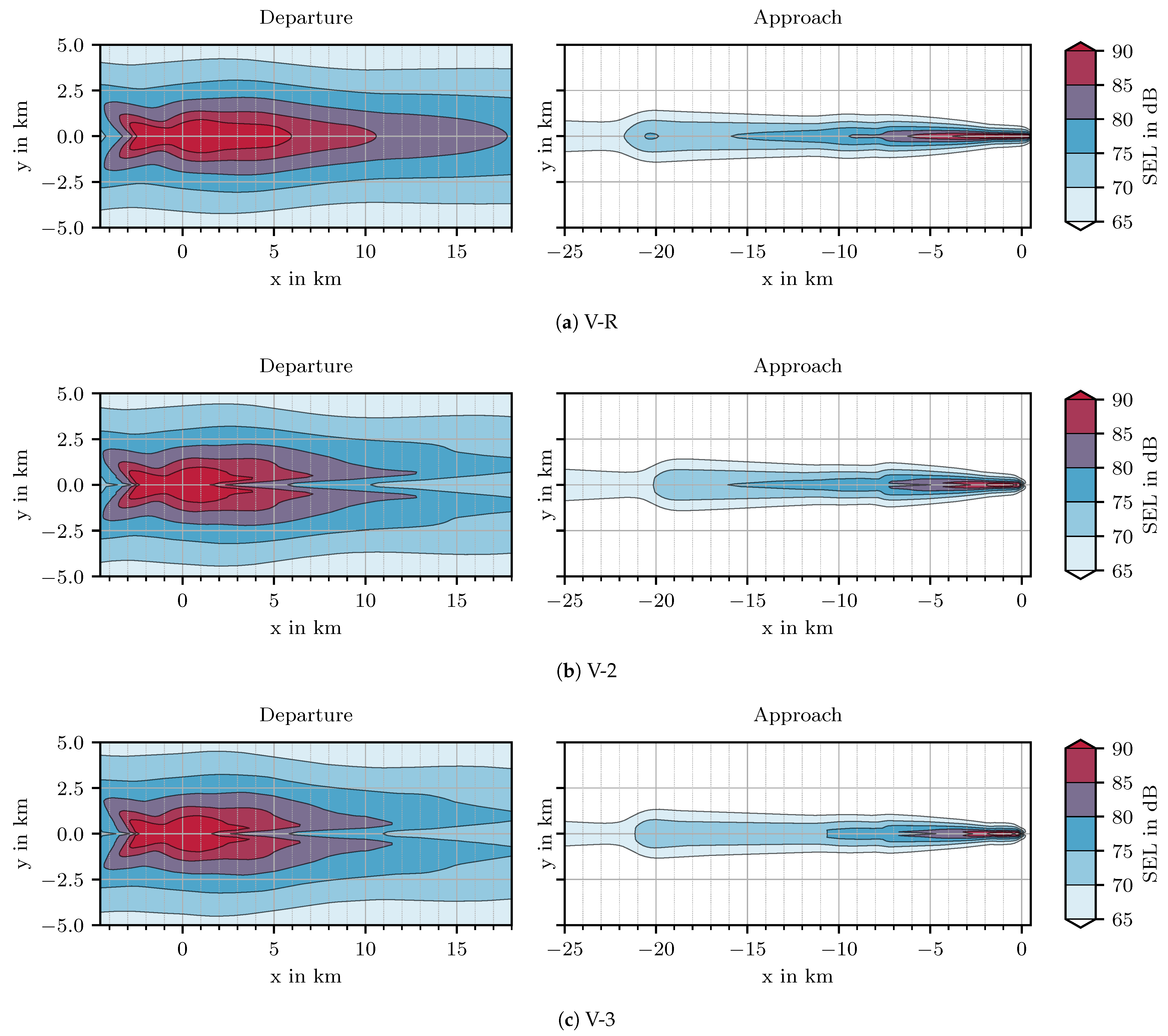
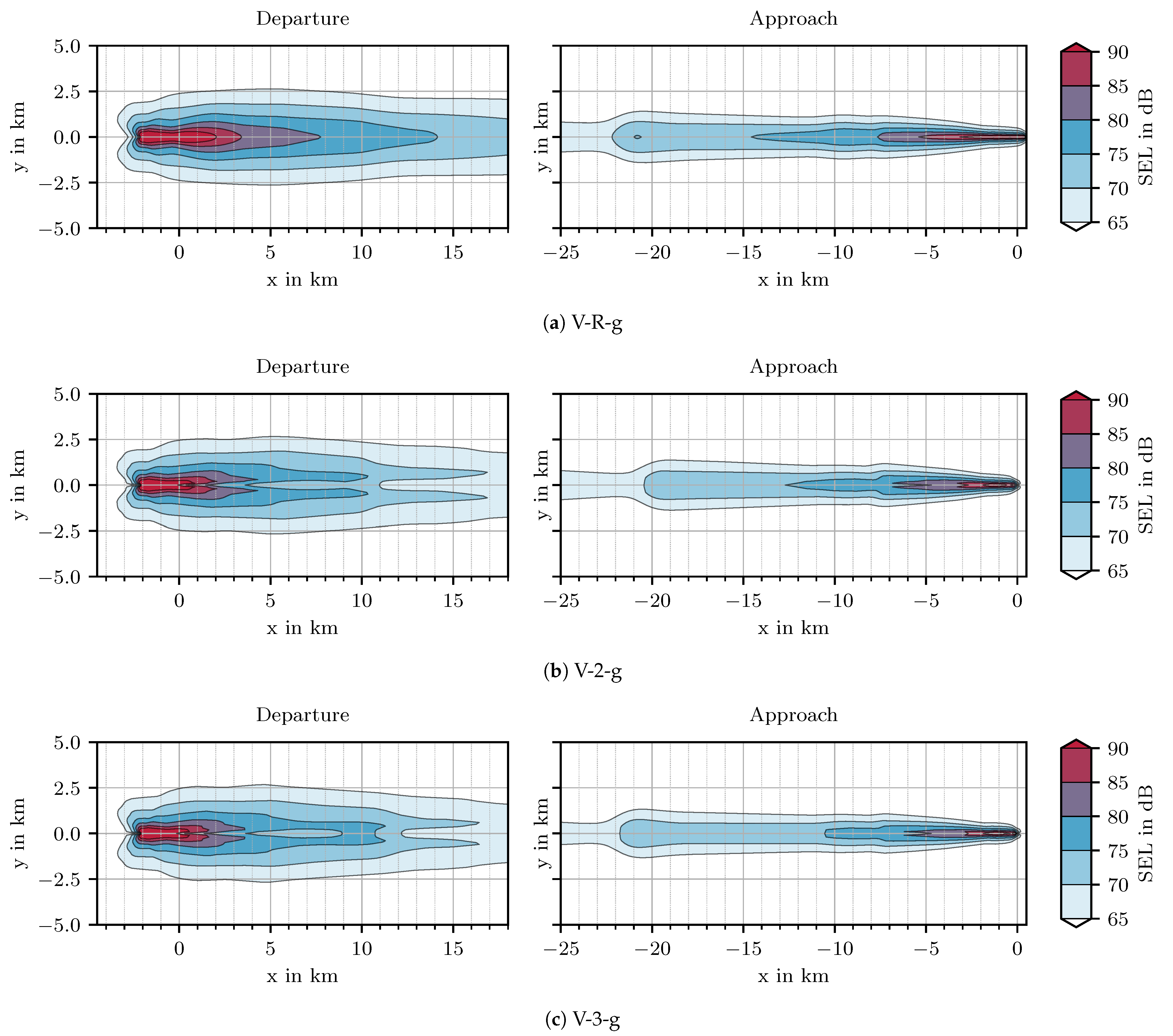
References
- High Level Group on Aviation Research. Flightpath 2050—Europe’s Vision for Aviation; Technical Report; European Commission: Brussels, Belgium, 2011. [Google Scholar] [CrossRef]
- Friedrichs, J. SE2A—Sustainable and Energy-Efficient Aviation, Cluster of Excellence, Full Proposal; Technical Report; TU Braunschweig: Braunschweig, Germany, 2018. [Google Scholar]
- International Civil Aviation Organization. Annex 16 to the Convention on International Civil Aviation: Environmental Protection: Volume I—Aircraft Noise, 5th ed.; AN 16-1, International Civil Aviation Organization (ICAO): Montreal, QC, Canada, 2008. [Google Scholar]
- Bertsch, L.; Heinze, W.; Guerin, S.; Lummer, M.; Delfs, J. 10 years of joint research at DLR and TU Braunschweig toward low-noise aircraft design–what did we achieve? Aeronaut. Aerosp. Open Access J. 2019, 3, 89–105. [Google Scholar] [CrossRef]
- Lee, D.S.; Fahey, D.W.; Forster, P.M.; Newton, P.J.; Wit, R.C.N.; Lim, L.L.; Owen, B.; Sausen, R. Aviation and global climate change in the 21st century. Atmos. Environ. 2009, 43, 3520–3537. [Google Scholar] [CrossRef] [PubMed]
- International Civil Aviation Organization (ICAO). ICAO Global Environmental Trends–Present and Future Aircraft Noise and Emissions; Technical Report; International Civil Aviation Organization (ICAO): Montreal, QC, Canada, 2019. [Google Scholar]
- Graver, B.; Rutherford, D.; Zheng, Z. CO2 Emissions from Commercial Aviation: 2013, 2018, and 2019; Technical Report; International Council on Clean Transportation (ICCT): Washington, DC, USA, 2020. [Google Scholar]
- Graver, B.; Zhang, K.; Rutherford, D. CO2 Emissions from Commercial Aviation, 2018; Technical Report 16; International Council on Clean Transportation (ICCT): Washington, DC, USA, 2019. [Google Scholar]
- Kärcher, B. Formation and radiative forcing of contrail cirrus. Nat. Commun. 2018, 9, 1824. [Google Scholar] [CrossRef] [PubMed]
- Isermann, U.; Bertsch, L. Aircraft Noise Immission Modeling. CEAS Aeronaut. J. 2019, 10, 287–311. [Google Scholar] [CrossRef]
- Blinstrub, J. Immission-Based Noise Reduction within Conceptual Aircraft Design; Technical Report DLR-FB-2019-12; DLR: Göttingen, Germany, 2019. [Google Scholar]
- Bertsch, L.; Clark, I.; Thomas, R.; Sanders, L.; LeGriffon, I. The Aircraft Noise Simulation Working Group (ANSWr)–Tool Benchmark and Reference Aircraft Results. In 25th AIAA/CEAS Aeroacoustics Conference; AIAA: Delft, The Netherlands, 2019. [Google Scholar] [CrossRef]
- Dobrzynski, W. Almost 40 Years of Airframe Noise Research: What Did We Achieve? J. Aircr. 2010, 47, 353–367. [Google Scholar] [CrossRef]
- Pieren, R.; Bertsch, L.; Lauper, D.; Schäffer, B. Improving future low-noise aircraft technologies using experimental perception-based evaluation of synthetic flyovers. Sci. Total. Environ. 2019, 692, 68–81. [Google Scholar] [CrossRef] [PubMed]
- Farokhi, S. Future Propulsion Systems and Energy Sources in Sustainable Aviation; John Wiley & Sons, Inc.: Hoboken, NJ, USA, 2020. [Google Scholar]
- Burkhardt, U.; Kärcher, B.; Schumann, U. Global Modeling of the Contrail and Contrail Cirrus Climate Impact. Bull. Am. Meteorol. Soc. 2010, 91, 479–484. [Google Scholar] [CrossRef]
- Airbus, Global Market Forecast 2021–2040. Available online: https://www.airbus.com/en/products-services/commercial-aircraft/market/global-market-forecast (accessed on 17 November 2021).
- Boeing, Commercial Market Outlook 2021–2040. Available online: https://www.boeing.com/commercial/market/commercial-market-outlook/ (accessed on 17 November 2021).
- Federal Aviation Administration. FAA Aerospace Forecast Fiscal Years 2021–2041; Technical Report; Federal Aviation Administration: Washington, DC, USA, 2021.
- Raymer, D.P. Aircraft Design: A Conceptual Approach, 6th ed.; AIAA Education Series; American Institute of Aeronautics and Astronautics Inc.: Reston, VA, USA, 2018. [Google Scholar]
- Habermann, A.L.; Bijewitz, J.; Seitz, A.; Hornung, M. Performance bookkeeping for aircraft configurations with fuselage wake-filling propulsion integration. CEAS Aeronaut. J. 2020, 11, 529–551. [Google Scholar] [CrossRef]
- Aigner, B.; Nollmann, M.; Stumpf, E. Design of a Hybrid Electric Propulsion System within a Preliminary Aircraft Design Software Environment. In Proceedings of the Luft- und Raumfahrt—Digitalisierung und Vernetzung: Deutscher Luft- und Raumfahrtkongress 2018, Bonn, Germany, 4–6 September 2018. [Google Scholar] [CrossRef]
- Karpuk, S.; Elham, A. Influence of Novel Airframe Technologies on the Feasibility of Fully-Electric Regional Aviation. Aerospace 2021, 8, 163. [Google Scholar] [CrossRef]
- Staggat, M.; Moreau, A.; Guérin, S. Analytical prediction of boundary layer ingestion noise for an integrated turbofan. In Proceedings of the 26th International Congress on Sound and Vibration (ICSV), International Institute of Acoustics and Vibration, Montreal, QC, Canada, 7–11 July 2019; Volume 26, pp. 1304–1311. [Google Scholar]
- Koch, A.; Nagel, B.; Grewe, V.; Dahlmann, K.; Schumann, U.; Gollnick, V.; Kärcher, B. Integrated Analysis and Design Environment for a Climate Compatible Air Transport System. In Proceedings of the 9th AIAA Aviation Technology, Integration, and Operations Conference (ATIO), American Institute of Aeronautics and Astronautics, Reston, VA, USA, 21–23 September 2009. [Google Scholar] [CrossRef]
- Dahlmann, K. Eine Methode zur Effizienten Bewertung von Maßnahmen zur Klimaoptimierung des Luftverkehrs. Ph.D. Thesis, Ludwig–Maximilians–Universität München, München, Germany, 2011. [Google Scholar] [CrossRef]
- Koch, A. Climate Impact Mitigation Potential Given by Flight Profile and Aircraft Optimization. Ph.D. Thesis, Technischen Universität Hamburg-Harburg, Hamburg, Germany, 2013. [Google Scholar] [CrossRef]
- Husemann, M.; Schäfer, K.; Schültke, F.; Aigner, B.; Stumpf, E. A Summary of the Climate Change Mitigation Potential through Climate-Optimized Aircraft Design; Technical Report; Institut für Luft- und Raumfahrtsysteme (ILR), RWTH Aachen University: Aachen, Germany, 2017. [Google Scholar] [CrossRef]
- Grewe, V.; Linke, F. Eco-efficiency in aviation. Meteorol. Z. 2017, 26, 689–696. [Google Scholar] [CrossRef]
- D02 Committee. ASTM D7566-16: Specification for Aviation Turbine Fuel Containing Synthesized Hydrocarbons. Available online: https://www.astm.org/d7566-09.html (accessed on 17 November 2021).
- Bertsch, L. Noise Prediction Within Conceptual Aircraft Design; Technical Report DLR-FB-2013-20; DLR, Deutsches Zentrum für Luft- und Raumfahrt (DLR): Göttingen, Germany, 2013. [Google Scholar] [CrossRef]
- Bertsch, L.; Wolters, F.; Heinze, W.; Pott-Pollenske, M.; Blinstrub, J. System Noise Assessment of a Tube-and-Wing Aircraft with Geared Turbofan Engines. J. Aircr. 2019, 56, 1577–1596. [Google Scholar] [CrossRef]
- Heinze, W. Ein Beitrag zur quantitativen Analyse der technischen und wirtschaftlichen Auslegungsgrenzen verschiedener Flugzeugkonzepte für den Transport grosser Nutzlasten. Technische Universität Braunschweig. In Zentrum für Luft- und Raumfahrttechnik; Inst. f. Flugzeugbau u. Leichtbau d. TU: Braunschweig, Germany, 1994. [Google Scholar]
- Werner-Spatz, C.; Heinze, W.; Horst, P. Improved Representation of High-Lift Devices for a Multidisciplinary Conceptual Aircraft Design Process. J. Aircr. 2009, 46, 1984–1994. [Google Scholar] [CrossRef]
- Lummer, M. Maggi-Rubinowicz Diffraction Correction for Ray-Tracing Calculations of Engine Noise Shielding. In 14th AIAA/CEAS Aeroacoustics Conference; AIAA: Vancouver, BC, Canada, 2008. [Google Scholar] [CrossRef]
- Koch, M.; Bertsch, L. Engine Noise Source Placement for Shielding Calculation; Inter Noise; Spanish Acoustical Society—SEA: Madrid, Spain, 2019. [Google Scholar]
- Seider, D.; Litz, M.; Schreiber, A.; Fischer, P.M.; Gerndt, A. Open source software framework for applications in aeronautics and space. In Proceedings of the 2012 IEEE Aerospace Conference, Big Sky, MT, USA, 3–10 March 2012; IEEE: Piscataway, NJ, USA, 2012; pp. 1–11. [Google Scholar] [CrossRef]
- Reitenbach, S.; Vieweg, M.; Becker, R.; Hollmann, C.; Wolters, F.; Schmeink, J.; Otten, T.; Siggel, M. Collaborative Aircraft Engine Preliminary Design using a Virtual Engine Platform, Part A: Architecture and Methodology. In AIAA Scitech 2020 Forum; American Institute of Aeronautics and Astronautics: Reston, VA, USA, 2020. [Google Scholar] [CrossRef]
- Rachner, M. Die Stoffeigenschaften von Kerosin Jet A-1. Technical Report. 1998. Available online: https://elib.dlr.de/3185/ (accessed on 17 November 2021).
- EASA. ICAO Engine Exhaust Emissions Databank. Available online: http://easa.europa.eu/document-library/icao-aircraft-engine-emissions-databank (accessed on 17 November 2021).
- DuBois, D.; Paynter, G.C. “Fuel Flow Method2” for Estimating Aircraft Emissions; SAE Technical Paper Series; SAE International: Warrendale, PA, USA, 2006. [Google Scholar] [CrossRef]
- Döpelheuer, A.; Lecht, M. Influence of Engine Performance on Emission Characteristics. In Gas Turbine Engine Combustion, Emissions and Alternative Fuels; NATO, Ed.; AC/323(AVT)TP; NATO Research and Technology Organization: Neuilly-sur-Seine, France, 1999. [Google Scholar]
- Döpelheuer, A. Anwendungsorientierte Verfahren zur Bestimmung von CO, HC und Ruß aus Luftfahrttriebwerken; Technical Report FB-2002-10; Institut für Antriebstechnik: Köln, Germany, 2002. [Google Scholar]
- Madden, P.; Park, K. Methodology for Predicting NOx Emissions at Altitude Conditions from Ground Level Engine Emissions and Performance Test Information; Technical Report DNS 90713; Rolls-Royce: Westhampnett, UK, 2003. [Google Scholar]
- Plohr, M.; von der Bank, R.; Schilling, T. Vergleich des Emissionsverhaltens effizienter Hochbypasstriebwerke mittlerer Schubgröße für den ICAO LTO-Zyklus und Flugmissionen. In Proceedings of the Deutscher Luft- und Raumfahrtkongress, München, Germany, 17–20 November 2003. [Google Scholar]
- Bertsch, L.; Sanders, L.; Thomas, R.H.; LeGriffon, I.; June, J.C.; Clark, I.A.; Lorteau, M. Comparative Assessment of Aircraft System Noise Simulation Tools. J. Aircr. 2021, 58, 867–884. [Google Scholar] [CrossRef]
- Dobrzynski, W.; Pott-Pollenske, M. Slat Noise Source Studies for Farfield Noise Prediction. In 7th AIAA/CEAS Aeroacoustics Conference; AIAA: Maastricht, The Netherlands, 2001. [Google Scholar] [CrossRef]
- Pott-Pollenske, M.; Dobrzynski, W.; Buchholz, H.; Gehlhar, B.; Walle, F. Validation of Semiempirical Airframe Noise prediction Method through Dedicated A319 Flyover Noise Measurements. In 8th AIAA/CEAS Aeroacoustics Conference; AIAA: Breckenridge, CO, USA, 2002. [Google Scholar] [CrossRef]
- Rossignol, K.S. Development of an empirical prediction model for flap side-edge noise. In 16th AIAA/CEAS Aeroacoustics Conference; AIAA: Stockholm, Sweden, 2010. [Google Scholar] [CrossRef]
- Rossignol, K.S. Empirical Prediction of Airfoil Tip Noise. In 17th AIAA/CEAS Aeroacoustics Conference; AIAA: Portland, ON, USA, 2011. [Google Scholar] [CrossRef]
- Dobrzynski, W.; Chow, L.; Guion, P.; Shiells, D. A European Study on Landing Gear Airframe Noise Sources. In 6th AIAA/CEAS Aeroacoustics Conference; AIAA: Lahaina, HI, USA, 2000. [Google Scholar] [CrossRef]
- Heidmann, M.F. Interim Prediction Method for Fan and Compressor Source Noise; Technical Report NASA TMX-71763; NASA Lewis Research Center: Cleveland, OH, USA, 1979.
- Stone, J.; Groesbeck, D.; Zola, C. Conventional profile coaxial jet noise prediction. AIAA J. 1983, 21, 336–342. [Google Scholar] [CrossRef]
- Lummer, M.; Hepperle, M.; Delfs, J. Towards a Tool for the Noise Assessment of Aircraft Configurations. In Proceedings of the 8th ASC-CEAS Workshop, Aeroacoustics of New Aircraft and Engine Configurations, Budapest, Hungry, 11–12 November 2004. [Google Scholar]
- A-21 Aircraft Noise Measurement Aviation Emission Modeling. Standard Values of Atmospheric Absorption as a Function of Temperature and Humidity; Technical Report; SAE International: Warrendale, PA, USA, 1975. [Google Scholar] [CrossRef]
- A-21 Aircraft Noise Measurement Aviation Emission Modeling. Prediction Method for Lateral Attenuation of Airplane Noise during Takeoff and Landing; Technical Report Aerospace Information Report, AIR 1751; SAE International: Warrendale, PA, USA, 1991. [Google Scholar] [CrossRef]
- Felix Greco, G.; Bertsch, L.; Ring, T.P.; Langer, S.C. Sound quality assessment of a medium-range aircraft with enhanced fan-noise shielding design. CEAS Aeronaut. J. 2021, 12, 481–493. [Google Scholar] [CrossRef]
- More, S.R. Aircraft Noise Characteristics and Metrics. Ph.D. Thesis, Purdue University, West Lafayette, IN, USA, 2011. [Google Scholar]
- Bertsch, L.; Guerin, S.; Looye, G.; Pott-Pollenske, M. The Parametric Aircraft Noise Analysis Module-status overview and recent applications. In 17th AIAA/CEAS Aeroacoustics Conference (32nd AIAA Aeroacoustics Conference); American Institute of Aeronautics and Astronautics: Reston, VA, USA, 2011. [Google Scholar] [CrossRef][Green Version]
- Bertsch, L.; Looye, G.; Anton, E.; Schwanke, S. Flyover Noise Measurements of a Spiraling Noise Abatement Approach Procedure. J. Aircr. 2011, 48, 436–448. [Google Scholar] [CrossRef]
- Bertsch, L.; Schäffer, B.; Guérin, S. Uncertainty Analysis for Parametric Aircraft System Noise Prediction. J. Aircr. 2019, 56, 529–544. [Google Scholar] [CrossRef]
- Hepperle, M. Environmental Friendly Transport Aircraft. Notes Numer. Fluid Mech. Multidiscip. Des. 2004, 87, 26–33. [Google Scholar] [CrossRef]
- Redeker, G.; Wichmann, G. Forward sweep—A favorable concept for a laminar flow wing. J. Aircr. 1991, 28, 97–103. [Google Scholar] [CrossRef]
- Risse, K. Preliminary Overall Aircraft Design with Hybrid Laminar Flow Control. Ph.D. Thesis, RWTH Aachen, Aachen, Germany, 2016. [Google Scholar]
- Seitz, A.; Horstmann, K.H. Design Studies on NLF and HLFC Applications at DLR. In ICAS 2010; Grant, I., Ed.; International Council of the Aeronautical Sciences: Nizza, France, 2010; Volume 27. [Google Scholar]
- Seitz, A.; Kruse, M.; Wunderlich, T.; Bold, J.; Heinrich, L. The DLR Project LamAiR: Design of a NLF Forward Swept Wing for Short and Medium Range Transport Application. In 29th AIAA Applied Aerodynamics Conference; American Institute of Aeronautics and Astronautics: Reston, VA, USA, 2011. [Google Scholar] [CrossRef]
- Seitz, A.; Hübner, A.; Risse, K. The DLR TuLam project: Design of a short and medium range transport aircraft with forward swept NLF wing. CEAS Aeronaut. J. 2019, 11, 449–459. [Google Scholar] [CrossRef]
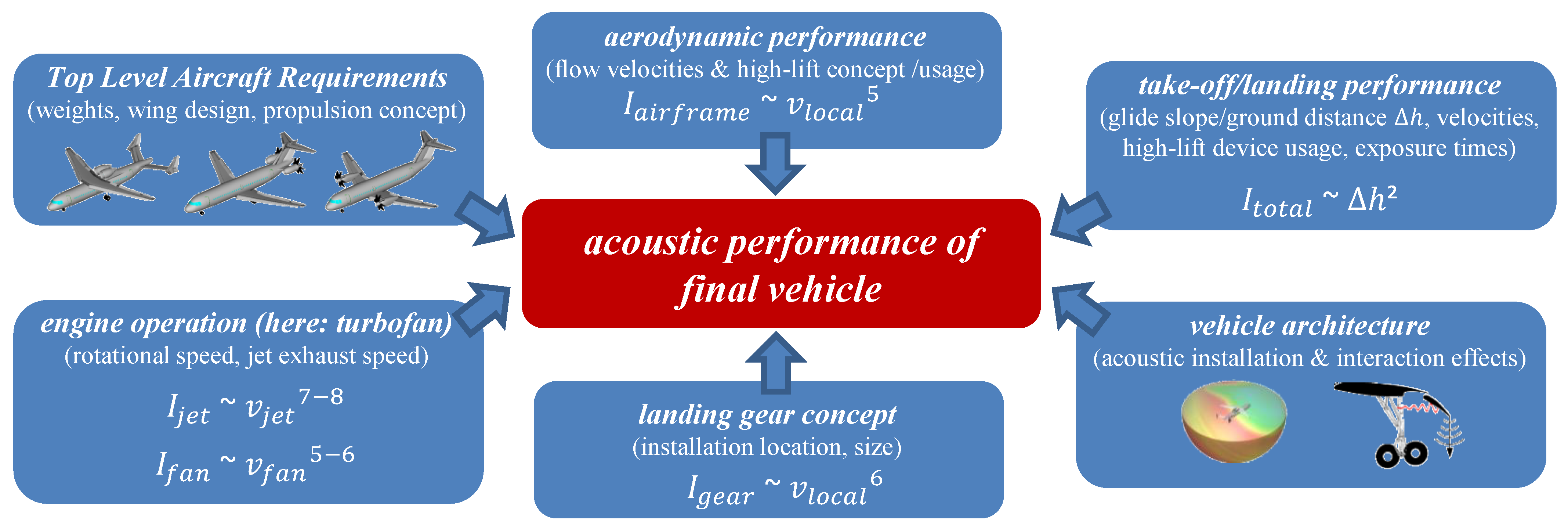
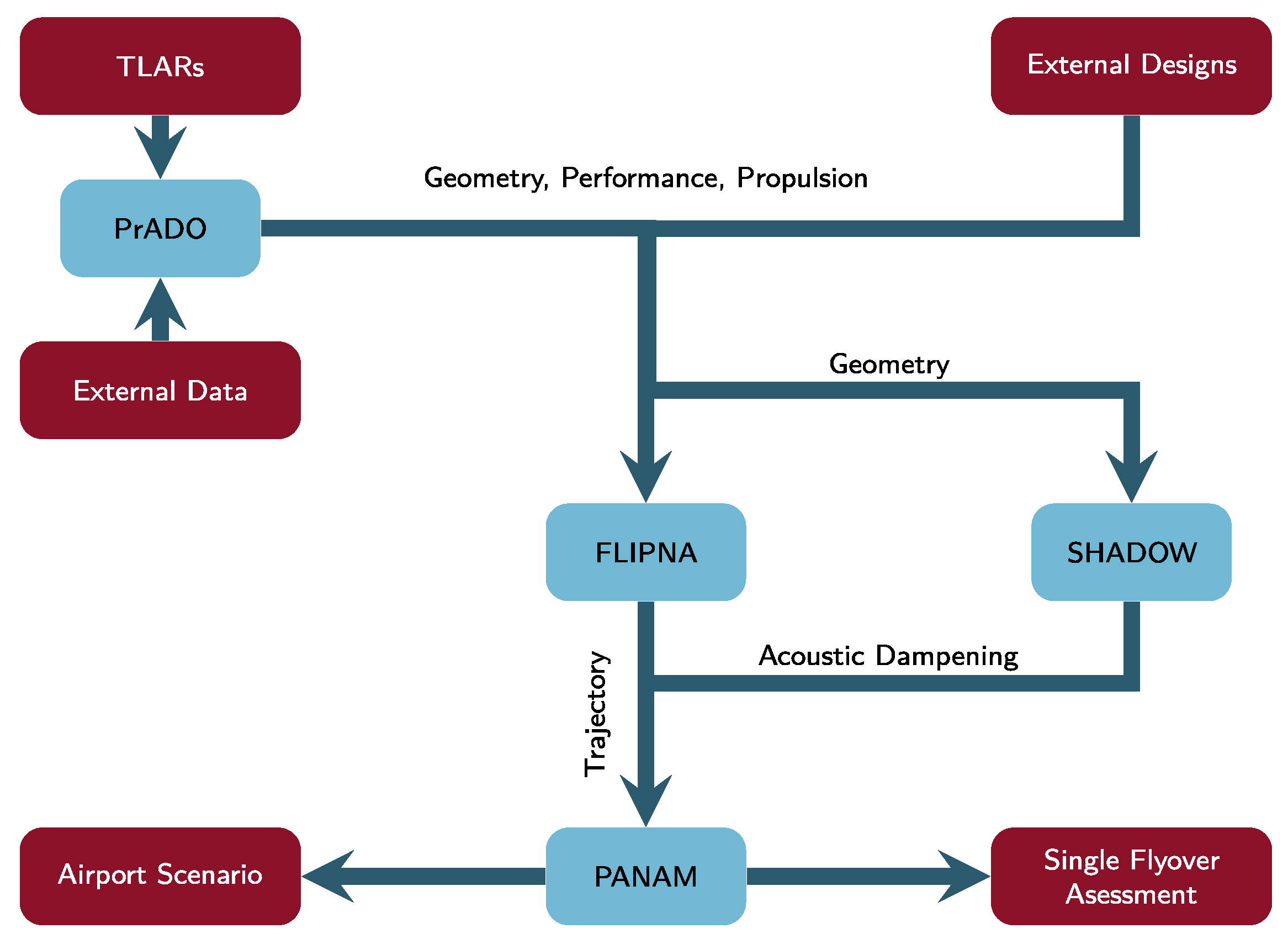

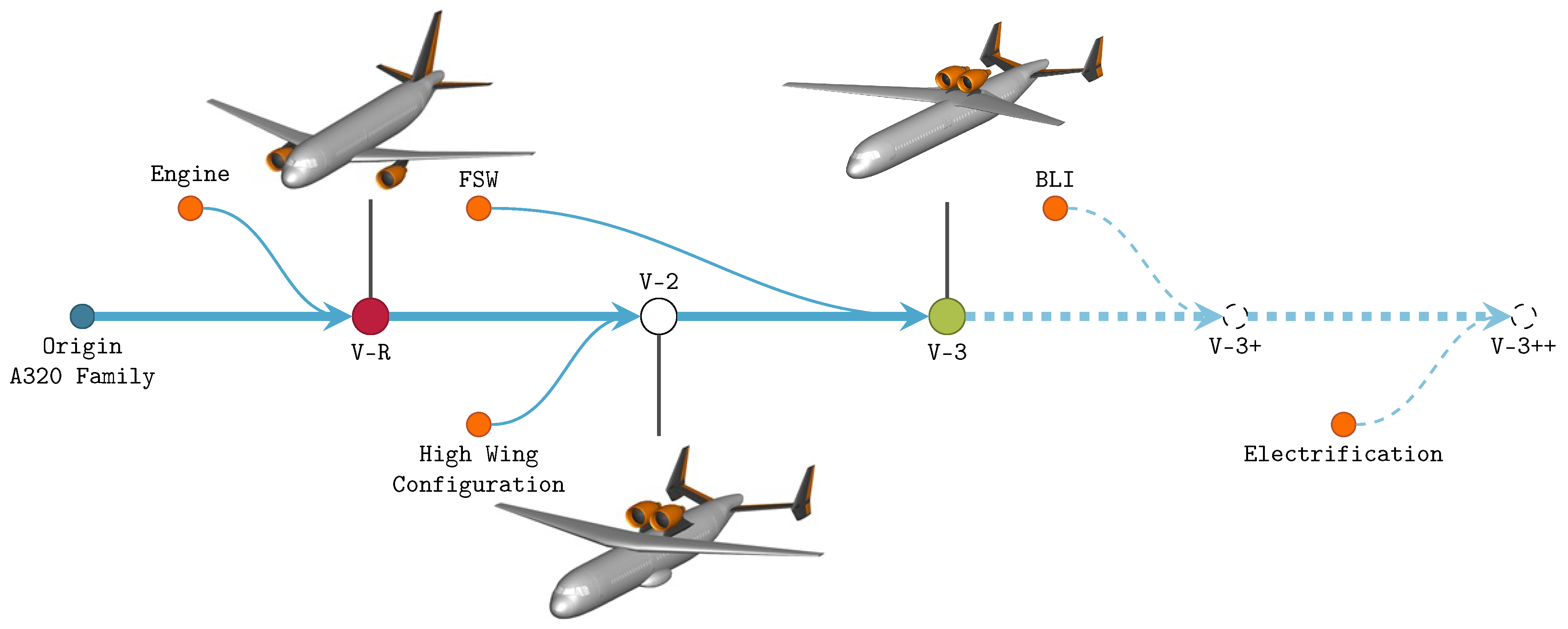
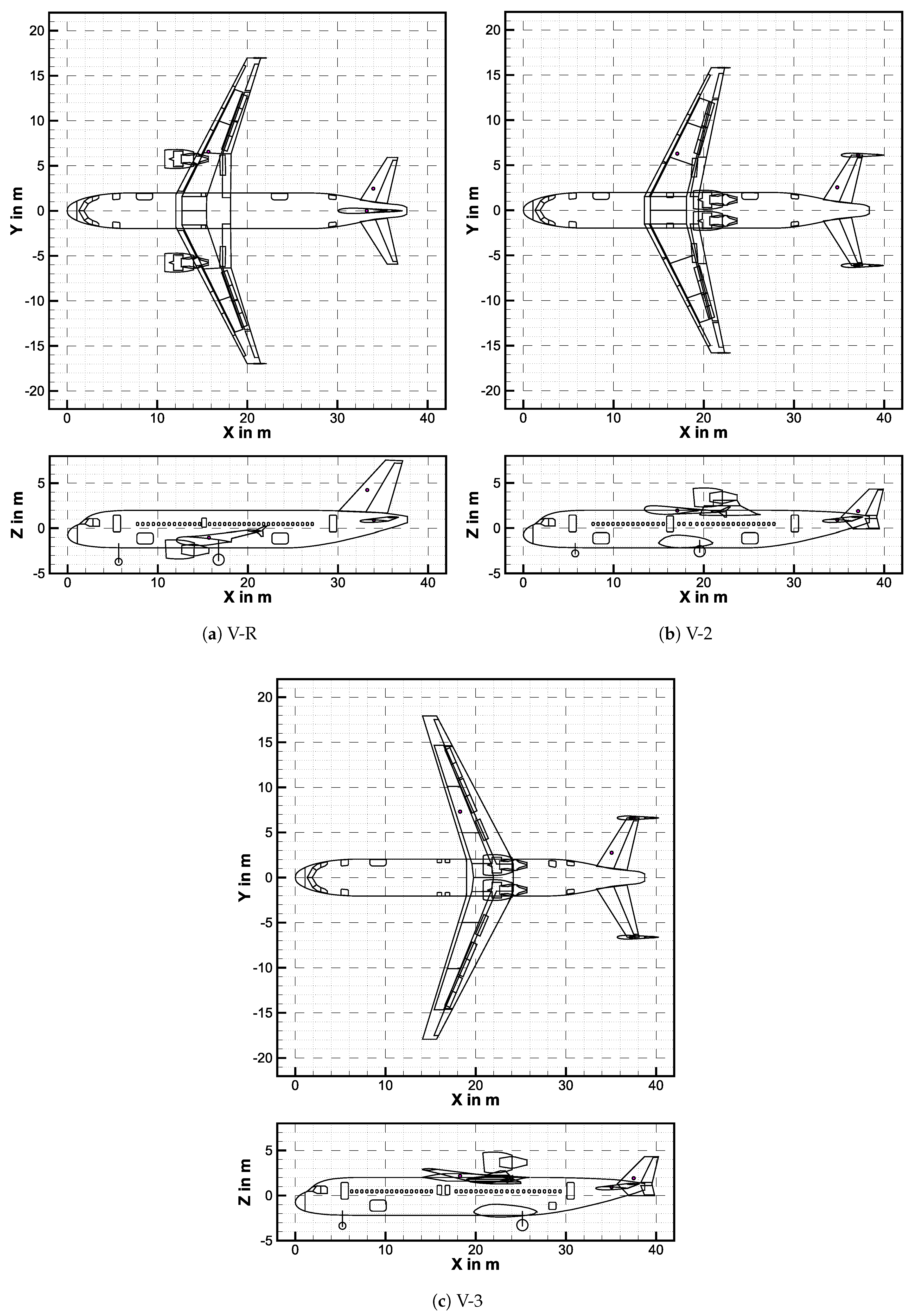

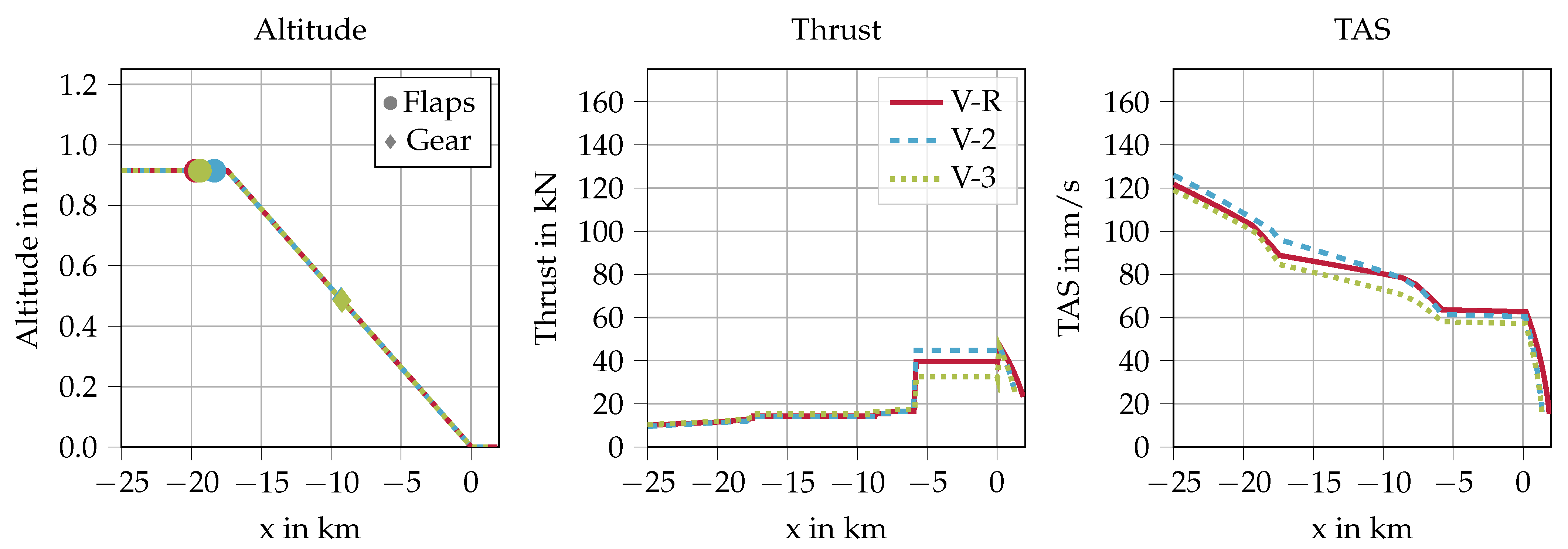
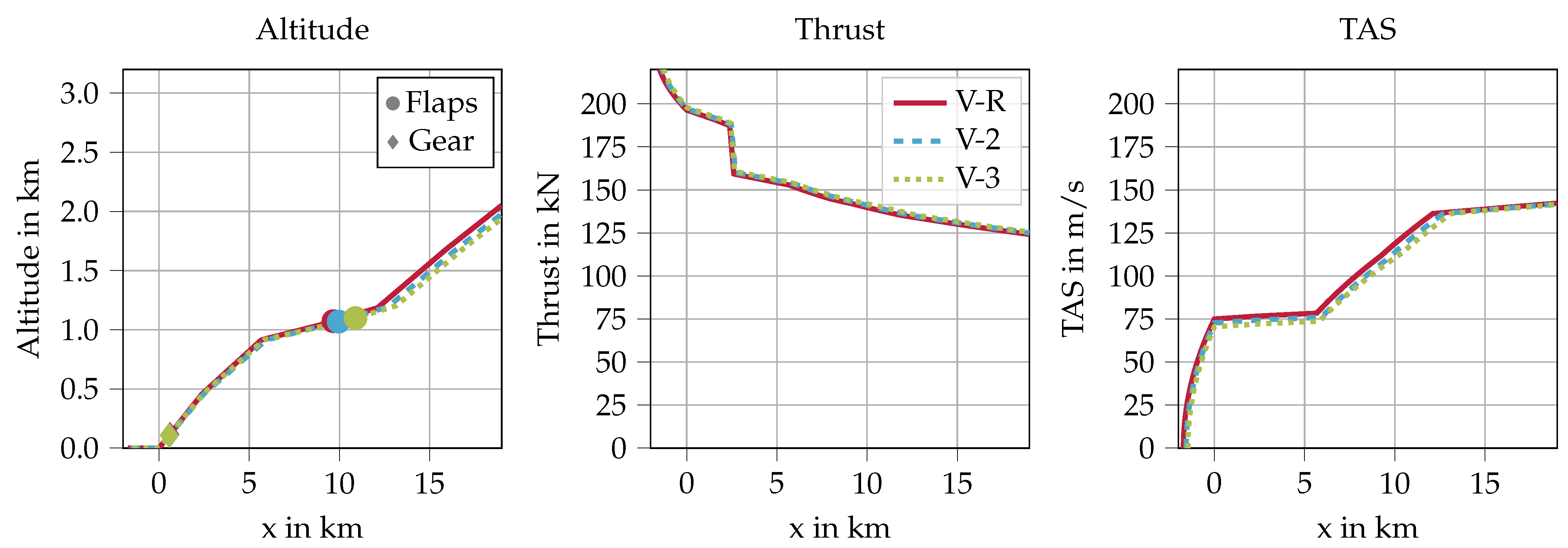
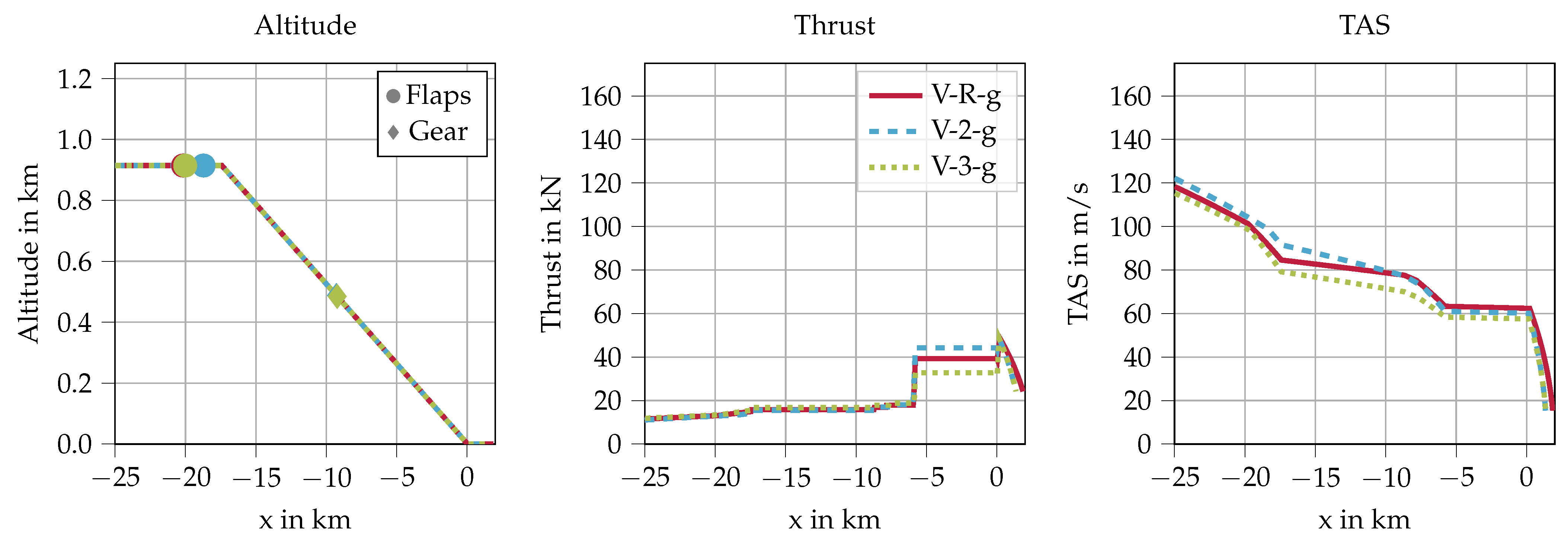
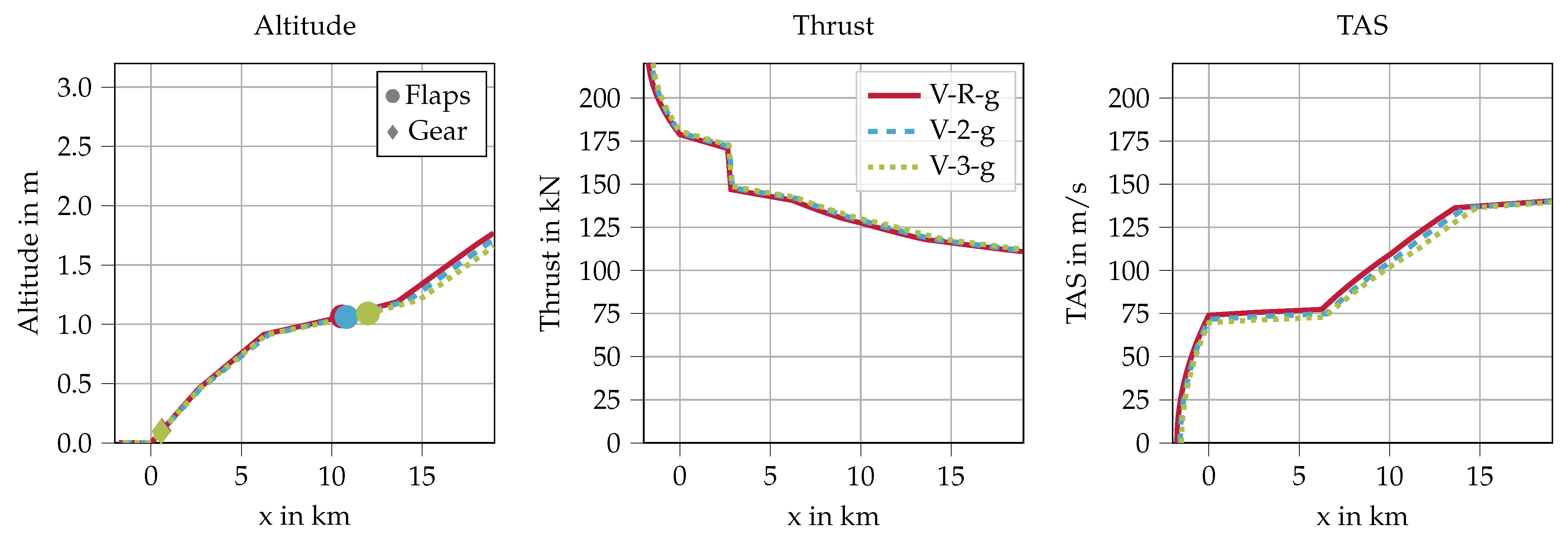
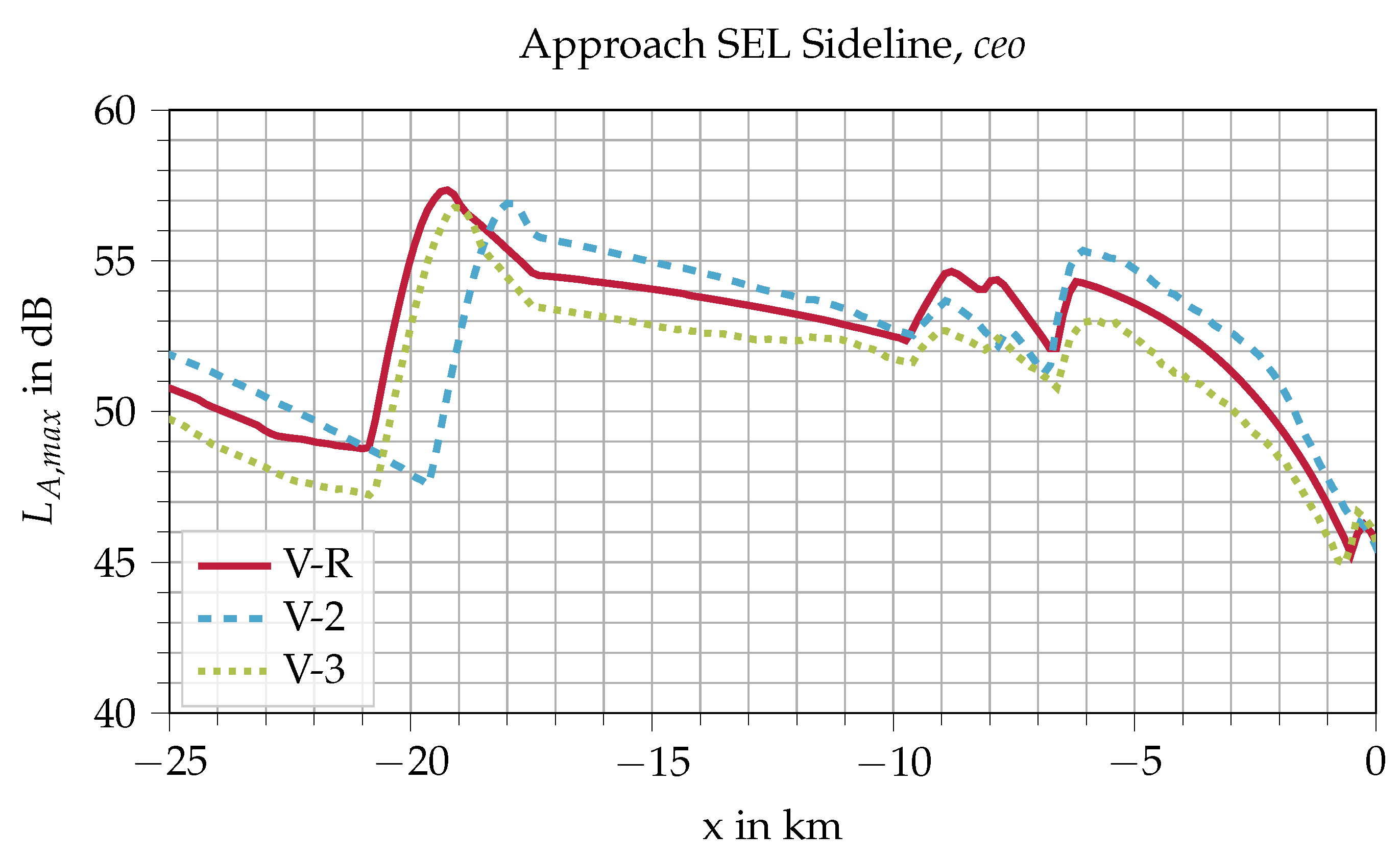
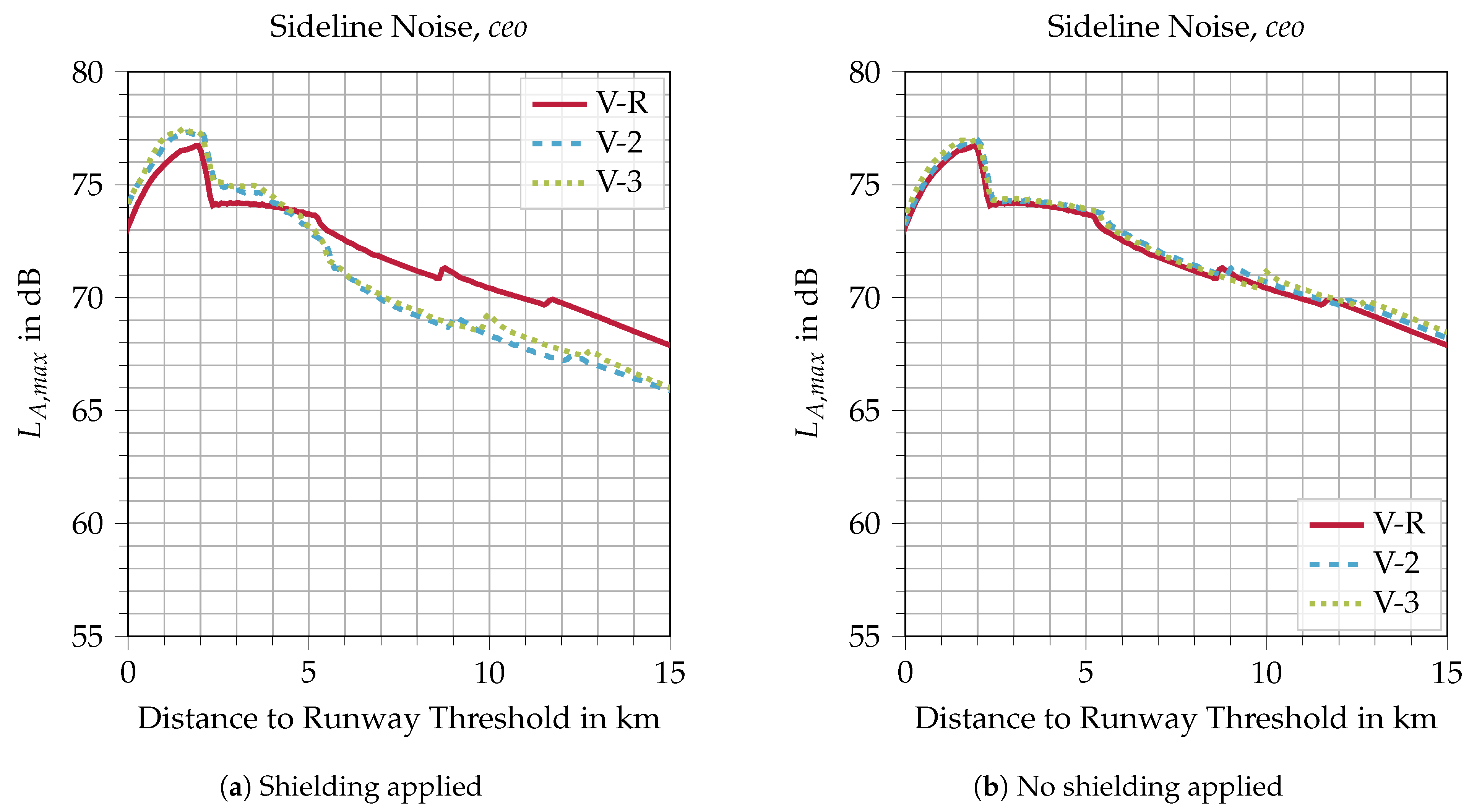
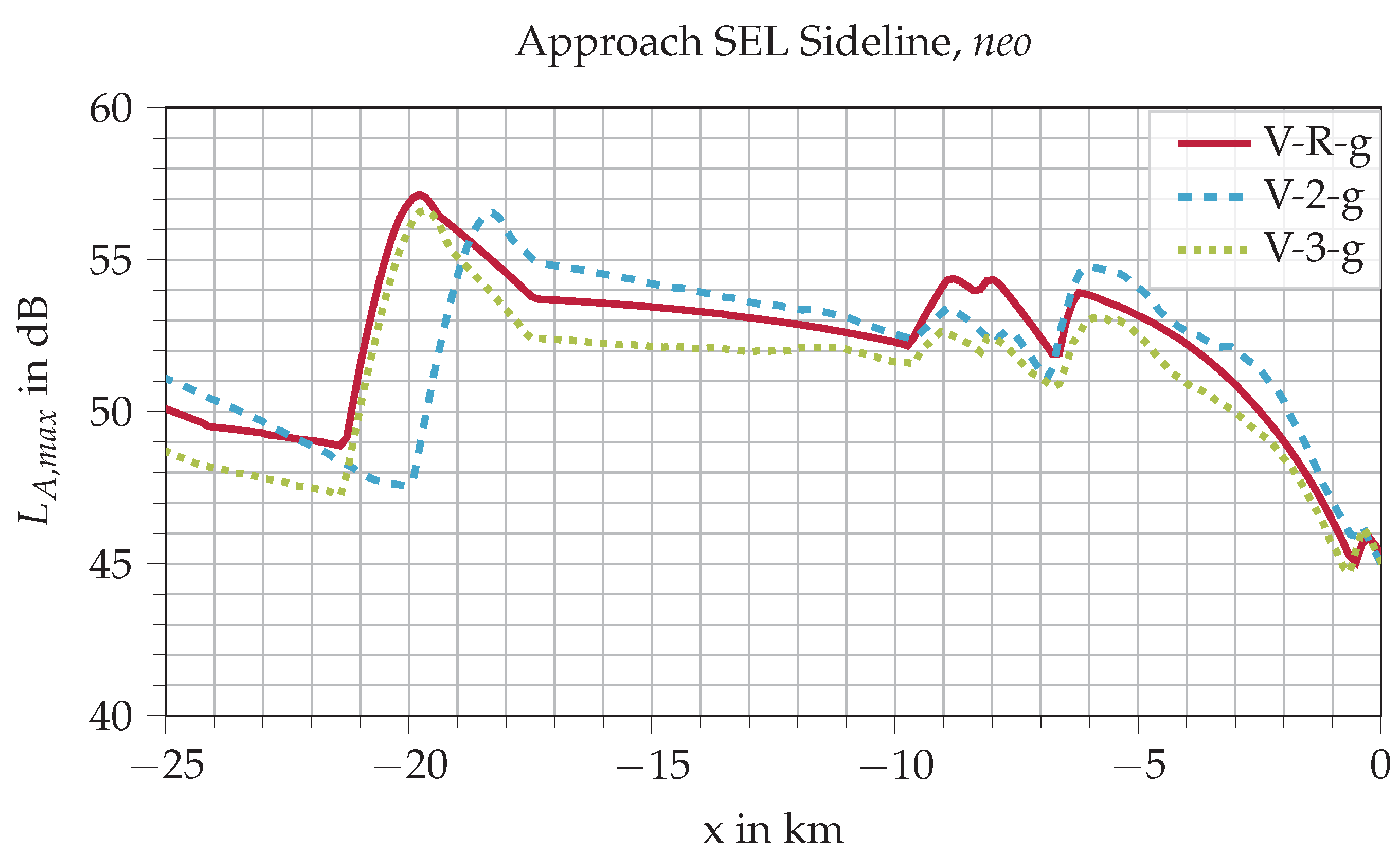


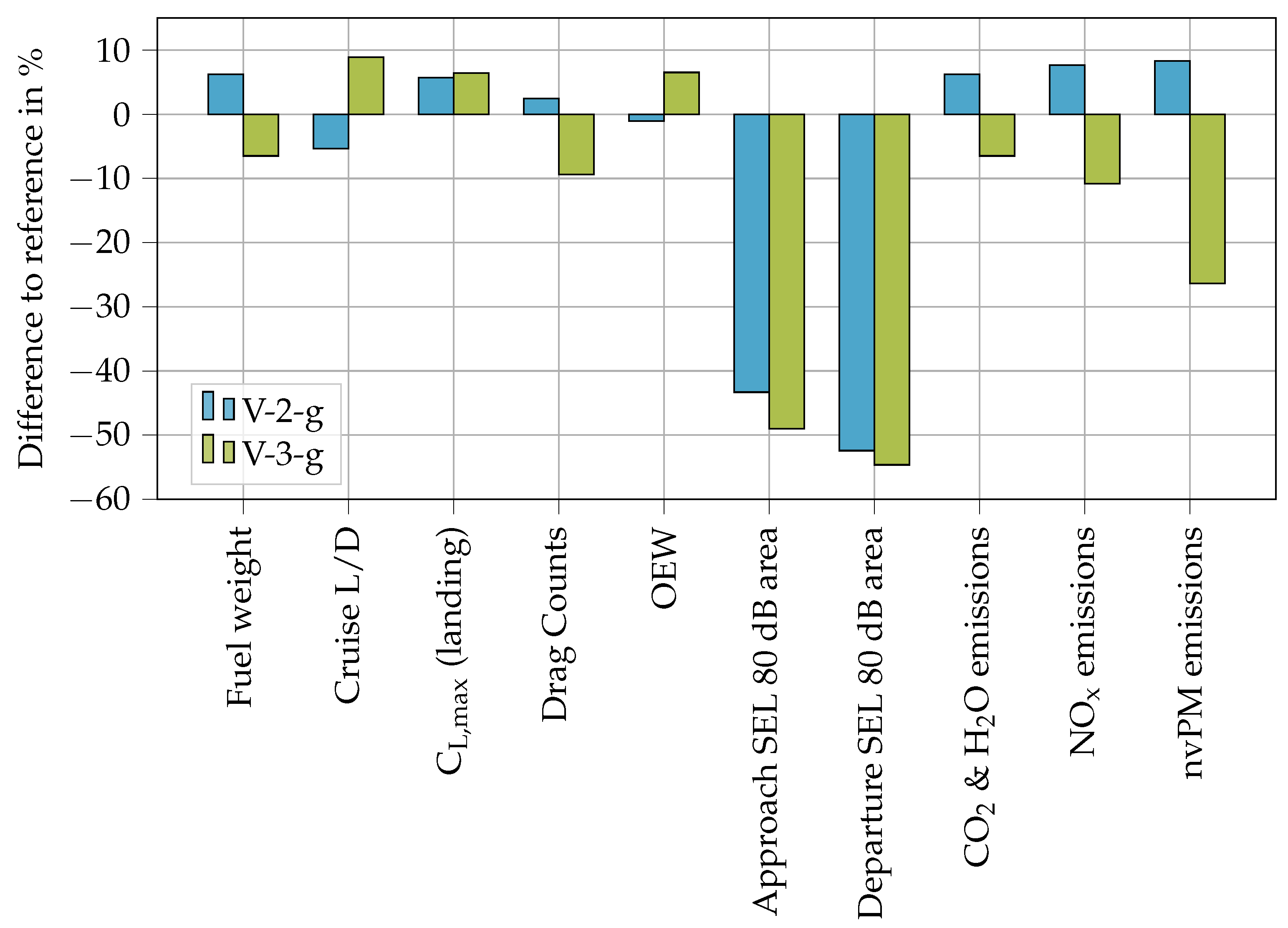
| Parameter | Requirement |
|---|---|
| No. of PAX | 150 |
| Range | 4500 km |
| Cruise Mach | 0.78 |
| Initial cruise alt. | 11,000 m |
| Source/Mechanism | References |
|---|---|
| trailing edge noise | DLR model [31,47,48,49,50,51] |
| leading edge noise | DLR model [31,47,48,51] |
| landing gear noise | DLR model [31,47,48,51] |
| fan noise | modified Heidmann model [52] |
| jet noise | modified Stone model [53] |
| noise shielding | DLR tool SHADOW [35,54] |
| atmospheric propagation | SAE standard 886A [55] |
| ground attenuation | SAE standard AIR1751 [56] |
| a/c Design | Architecture | Engine Option | BPR |
|---|---|---|---|
| V-R | reference | ceo | 6 |
| V-R-g | reference | neo | 12 |
| V-2 | noise-shielding | ceo | 6 |
| V-2-g | noise-shielding | neo | 12 |
| V-3 | noise-shielding, foward-swept wing | ceo | 6 |
| V-3-g | noise-shielding, foward-swept wing | neo | 12 |
| Parameter | V-R | V-R-g | V-2 | V-2-g | V-3 | V-3-g |
|---|---|---|---|---|---|---|
| Propulsion | ||||||
| Engine BPR | 6 | 12 | 6 | 12 | 6 | 12 |
| Static thrust in kN | 116.56 | 121.39 | 116.56 | 121.39 | 116.56 | 121.39 |
| TET in K | 1803.66 | 1883.14 | 1803.66 | 1883.140 | 1803.66 | 1883.14 |
| OPR | 29.0 | 34.6 | 29.0 | 34.6 | 29.0 | 34.6 |
| FPR | 1.80 | 1.51 | 1.80 | 1.51 | 1.80 | 1.51 |
| TSFC in g/kN/s | 11.51 | 7.68 | 11.51 | 7.68 | 11.51 | 7.68 |
| Fan diameter in m | 1.37 | 1.65 | 1.37 | 1.65 | 1.37 | 1.65 |
| Rel. pos. X in % | 28.75 | 28.75 | 47.26 | 47.26 | 51.75 | 51.75 |
| Rel. pos. Y in % | 33.88 | 33.88 | 7.39 | 7.39 | 7.74 | 7.74 |
| Total weights | ||||||
| OEW in kg | 38,721 | 39,907 | 38,317 | 39,494 | 41,256 | 42,512 |
| Max. takeoff in kg | 68,341 | 66,416 | 67,782 | 65,627 | 68,901 | 67,140 |
| Max. landing in kg | 63,779 | 63,192 | 62,820 | 62,098 | 57,512 | 58,143 |
| Component weights | ||||||
| Fuselage in kg | 9221 | 9214 | 10,218 | 10,228 | 9426 | 9425 |
| Wing in kg | 7231 | 7301 | 5689 | 5744 | 8863 | 8968 |
| HTP in kg | 504 | 504 | 576 | 576 | 691 | 691 |
| VTP in kg | 420 | 420 | 396 | 396 | 378 | 378 |
| Propulsion sys. in kg | 6873 | 8053 | 6873 | 8053 | 6985 | 8165 |
| Landing gear in kg | 2183 | 2167 | 1937 | 1912 | 2008 | 2022 |
| Fuselage | ||||||
| Length in m | 37.70 | 37.70 | 39.90 | 39.90 | 40.25 | 40.25 |
| Wing | ||||||
| Span width in m | 33.96 | 33.96 | 31.64 | 31.64 | 35.86 | 35.86 |
| Reference area in m2 | 122.60 | 122.60 | 125.00 | 125.00 | 126.00 | 126.00 |
| Aspect ratio | 9.40 | 9.40 | 8.00 | 8.00 | 10.20 | 10.20 |
| c/4 sweep angle in deg | 23.98 | 23.98 | 23.29 | 23.29 | −19.32 | −19.32 |
| l. e. sweep in deg | 27.48 | 27.48 | 26.91 | 26.91 | −16.47 | −16.47 |
| Horizontal tailplane | ||||||
| Span width in m | 11.83 | 11.83 | 12.25 | 12.25 | 13.23 | 13.23 |
| Reference area in m2 | 28.00 | 28.00 | 30.00 | 30.00 | 35.00 | 35.00 |
| Vertical tailplane | ||||||
| Span width in m | 5.87 | 5.87 | 4.42 | 4.42 | 4.33 | 4.33 |
| Reference area in m2 | 21.50 | 21.50 | 13.00 | 13.00 | 12.50 | 12.50 |
| Landing gear length | ||||||
| Front gear in m | 2.27 | 2.27 | 1.34 | 1.34 | 1.90 | 1.90 |
| Main gear in m | 2.75 | 2.75 | 1.78 | 1.78 | 2.09 | 2.09 |
| Performance along design mission | ||||||
| Max. CL (land.) | 3.09 | 3.08 | 3.24 | 3.26 | 3.26 | 3.28 |
| Cruise L/D | 17.61 | 17.48 | 16.62 | 16.55 | 19.13 | 19.04 |
| Cruise CL | 0.55 | 0.54 | 0.53 | 0.52 | 0.54 | 0.53 |
| Cruise Mach | 0.78 | 0.78 | 0.78 | 0.78 | 0.78 | 0.78 |
| Block time in h | 5.68 | 5.69 | 5.64 | 5.65 | 5.68 | 5.68 |
| Fuel in kg/100 km/seat | 1.80 | 1.43 | 1.91 | 1.52 | 1.69 | 1.33 |
| Max. field length in m | 1932 | 1917 | 1545 | 1449 | 1456 | 1399 |
| DOCs in Ct/SKM | 2.69 | 2.60 | 2.71 | 2.59 | 2.73 | 2.62 |
| Vehicle | Component | Departure | Cruise | Approach | Total | % |
|---|---|---|---|---|---|---|
| V-R | Fuel in kg | 1450 | 10,096 | 490 | 12,036 | (–) |
| CO2 in kg | 4577 | 31,876 | 1549 | 38,001 | (–) | |
| H2O in kg | 1793.5 | 12,490.5 | 606.8 | 14,890.9 | (–) | |
| NOx in kg | 35.1 | 109.6 | 3.2 | 147.9 | (–) | |
| nvPM in g | 67.3 | 61.0 | 0.5 | 128.8 | (–) | |
| V-2 | Fuel in kg | 1468 | 10861 | 527 | 12,855 | +6.8 |
| CO2 in kg | 4634.2 | 34,290.1 | 1662.8 | 40,587.0 | +6.8 | |
| H2O in kg | 1815.9 | 13,436.7 | 651.6 | 15,904.2 | +6.8 | |
| NOx in kg | 34.6 | 121.5 | 3.9 | 160.1 | +8.2 | |
| nvPM in g | 65.5 | 73.8 | 0.5 | 139.8 | +8.5 | |
| V-3 | Fuel in kg | 1423 | 9386 | 468 | 11,277 | −6.3 |
| CO2 in kg | 4492.9 | 29,634.1 | 1477.6 | 35,605.0 | −6.3 | |
| H2O in kg | 1760.6 | 11,612.2 | 579.0 | 13,951.8 | −6.3 | |
| NOx in kg | 34.9 | 97.6 | 3.0 | 135.6 | −8.3 | |
| nvPM in g | 67.2 | 42.3 | 0.5 | 110.0 | −14.6 |
| Vehicle | Component | Departure | Cruise | Approach | Total | % | % V-R |
|---|---|---|---|---|---|---|---|
| V-R-g | Fuel in kg | 1282 | 7997 | 373 | 9652 | (−) | −11.6 |
| CO2 in kg | 4046.2 | 25,249.3 | 1178.3 | 30,474.0 | (−) | −11.6 | |
| H2O in kg | 1585.5 | 9894.0 | 461.7 | 11,941.3 | (−) | −11.6 | |
| NOx in kg | 28.5 | 100.5 | 3.2 | 132.2 | (−) | −18.8 | |
| nvPM in g | 99.7 | 146.1 | 3.4 | 249.2 | (−) | 48.1 | |
| V-2-g | Fuel in kg | 1363 | 8482 | 410 | 10255 | 6.3 | −7.2 |
| CO2 in kg | 4304.3 | 26,778.7 | 1295.9 | 32,379.0 | 6.3 | −7.2 | |
| H2O in kg | 1686.7 | 10,493.3 | 507.8 | 12,687.8 | 6.3 | −7.2 | |
| NOx in kg | 29.3 | 109.4 | 3.7 | 142.4 | 7.7 | −15.3 | |
| nvPM in g | 99.7 | 166.6 | 3.6 | 269.9 | 8.3 | 52.2 | |
| V-3-g | Fuel in kg | 1219 | 7450 | 357 | 9027 | −6.5 | −14.3 |
| CO2 in kg | 3849.7 | 23,521.2 | 1128.5 | 28,499.0 | −6.5 | −14.3 | |
| H2O in kg | 1508.5 | 9216.9 | 442.2 | 11,167.6 | −6.5 | −14.3 | |
| NOx in kg | 27.6 | 87.2 | 3.0 | 117.9 | −10.8 | −20.9 | |
| nvPM in g | 98.2 | 82.0 | 3.3 | 183.5 | −26.4 | 46.1 |
| SEL Level in dB | V-R | V-2 | V-3 |
|---|---|---|---|
| approach | |||
| 75 | 12.18 | 10.97 | 7.45 |
| 80 | 4.57 | 3.75 | 2.57 |
| 85 | 1.87 | 1.17 | 1.00 |
| 90 | 0.18 | 0.11 | 0.12 |
| departure | |||
| 75 | – | – | 113.52 |
| 80 | 66.60 | 53.15 | 51.17 |
| 85 | 28.67 | 22.90 | 21.93 |
| 90 | 11.34 | 8.32 | 8.27 |
| SEL Level in dB | V-R-g | V-2-g | V-3-g |
|---|---|---|---|
| approach | |||
| 75 | 10.21 (−16.2) | 8.57 (−21.9) | 6.81 (−8.6) |
| 80 | 3.26 (−28.7) | 2.38 (−36.5) | 2.14 (−16.7) |
| 85 | 1.57 (−16.0) | 0.84 (−28.2) | 0.72 (−28.0) |
| 90 | 0.27 (50.0) | 0.14 (27.3) | 0.19 (58.3) |
| departure | |||
| 75 | 30.34 (–) | 21.43 (–) | 21.88 (−80.7) |
| 80 | 11.76 (−82.3) | 7.01 (−86.8) | 6.69 (−86.9) |
| 85 | 4.76 (−83.4) | 3.18 (−86.1) | 3.02 (−86.2) |
| 90 | 2.11 (−81.4) | 1.46 (−82.5) | 1.33 (−83.9) |
Publisher’s Note: MDPI stays neutral with regard to jurisdictional claims in published maps and institutional affiliations. |
© 2021 by the authors. Licensee MDPI, Basel, Switzerland. This article is an open access article distributed under the terms and conditions of the Creative Commons Attribution (CC BY) license (https://creativecommons.org/licenses/by/4.0/).
Share and Cite
Domogalla, V.; Bertsch, L.; Plohr, M.; Stumpf, E.; Spakovszky, Z.S. Low-Noise Design of Medium-Range Aircraft for Energy Efficient Aviation. Aerospace 2022, 9, 3. https://doi.org/10.3390/aerospace9010003
Domogalla V, Bertsch L, Plohr M, Stumpf E, Spakovszky ZS. Low-Noise Design of Medium-Range Aircraft for Energy Efficient Aviation. Aerospace. 2022; 9(1):3. https://doi.org/10.3390/aerospace9010003
Chicago/Turabian StyleDomogalla, Vincent, Lothar Bertsch, Martin Plohr, Eike Stumpf, and Zoltán S. Spakovszky. 2022. "Low-Noise Design of Medium-Range Aircraft for Energy Efficient Aviation" Aerospace 9, no. 1: 3. https://doi.org/10.3390/aerospace9010003
APA StyleDomogalla, V., Bertsch, L., Plohr, M., Stumpf, E., & Spakovszky, Z. S. (2022). Low-Noise Design of Medium-Range Aircraft for Energy Efficient Aviation. Aerospace, 9(1), 3. https://doi.org/10.3390/aerospace9010003








